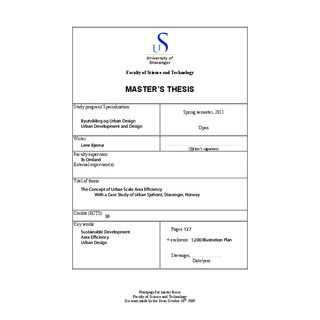| dc.contributor.author | Bjørnø, Lene | |
| dc.date.accessioned | 2011-10-07T16:14:49Z | |
| dc.date.available | 2011-10-07T16:14:49Z | |
| dc.date.issued | 2011 | |
| dc.identifier.uri | http://hdl.handle.net/11250/182038 | |
| dc.description | Master's thesis in Urban development and design | en_US |
| dc.description.abstract | This thesis focuses on area efficiency in the urban scale. It uses Urban Sjøfront in Stavanger as a case study. Area efficiency can be defined as reducing the need and use of new built form and land, through using excising areas more efficient.
The first aim of the thesis is to show area efficiency as a valid way of creating a sustainable city. Through chapter three, the thesis further investigate different theories concerning area efficiency in the urban environment, concluding with two characteristics of urban area efficiency: Shared monofunctional space and shared multifunctional space. The area efficient theories studied, together with social urban theories from among other Gehl (2003) and Oldenburg’s (1989) third places, builds the theoretical framework for the thesis. This framework is used to create an analysis and testing tool, in order to analyse the area efficiency in the case study of Urban Sjøfront. The thesis proposes two ways of analysing area efficiency. The first is the “pure” or spatial, relating only the built environment and land. The second is the “social” area effi ciency, relating to creating dense areas that also are good to live in, through also providing access to qualities and functions.
On the basis of the analysis and as well research on how people in the area live and view their living, threats and problems are identified in the case study area. Solutions for the problems are then suggested, through conceptual suggestions, followed by a design for a specific plot in the Urban Sjøfront case study area.
Concerning the threats to area efficiency in the case study, the main findings can be said to be the lack of sharing space and functions. This can be seen as a result of privacy concerns. The thesis also look at the social aspect of densification, debating that access to different functions is an important concern in order to reduce the space use per person, and still create good living conditions. It also question the actual urbanity in Urban Sjøfront, or if the area is developing to become yet another residential area. | en_US |
| dc.language.iso | eng | en_US |
| dc.publisher | University of Stavanger, Norway | en_US |
| dc.relation.ispartofseries | Masteroppgave/UIS-TN-IØRP/2011; | |
| dc.subject | sustainable development | en_US |
| dc.subject | area efficiency | en_US |
| dc.subject | urban design | en_US |
| dc.subject | byutvikling | en_US |
| dc.title | The concept of urban scale area efficiency, with a case study of Urban Sjøfront, Stavanger, Norway | en_US |
| dc.type | Master thesis | en_US |
| dc.subject.nsi | VDP::Social science: 200::Urbanism and physical planning: 230 | en_US |
